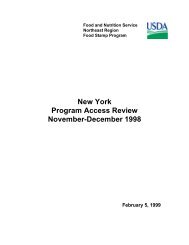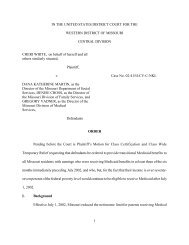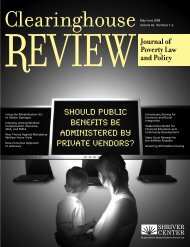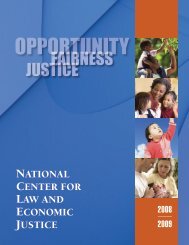The Role of the Courts in Securing Welfare Rights and ...
The Role of the Courts in Securing Welfare Rights and ...
The Role of the Courts in Securing Welfare Rights and ...
You also want an ePaper? Increase the reach of your titles
YUMPU automatically turns print PDFs into web optimized ePapers that Google loves.
<strong>Welfare</strong> Law CenterIn what k<strong>in</strong>ds <strong>of</strong> welfare cases have ADA claims been raised?<strong>The</strong> follow<strong>in</strong>g examples illustrate <strong>the</strong> range <strong>of</strong> problems for which pla<strong>in</strong>tiffs have soughtrelief under <strong>the</strong> ADA. (In some cases <strong>the</strong>re may have been Rehabilitation Act claims as well.)Note that some cases do not rely exclusively on <strong>the</strong> ADA but raise o<strong>the</strong>r legal claims as well. Inaddition, <strong>in</strong> some cases <strong>the</strong> court did not reach a decision because <strong>the</strong> parties settled <strong>the</strong> case.Eligibility criteriaAFDC program rules: <strong>The</strong>re was litigation over <strong>the</strong> AFDC option to cover children upto age 19 if <strong>the</strong>y were expected to graduate from secondary school by age 19. Pla<strong>in</strong>tiffschallenged state decisions to deny AFDC to 18 year old high school students who were not likelyto graduate from high school before <strong>the</strong>ir 19 th birthdays because <strong>of</strong> <strong>the</strong>ir disabilities. ADAchallenges <strong>in</strong> two cases resulted <strong>in</strong> one favorable decision <strong>and</strong> one unfavorable decision. InHoward v. Dept. <strong>of</strong> Social <strong>Welfare</strong>, 26 <strong>the</strong> Vermont court concluded that <strong>the</strong> requirement was notan essential eligibility requirement. It rejected arguments that federal law m<strong>and</strong>ated <strong>the</strong>requirement, f<strong>in</strong>d<strong>in</strong>g that <strong>the</strong> state could fund such benefits on its own, that <strong>the</strong>re was noevidence that HHS has refused to make reasonable accommodations by provid<strong>in</strong>g federalmatch<strong>in</strong>g for <strong>in</strong>dividual cases to avoid discrim<strong>in</strong>ation based on disability, <strong>and</strong> that <strong>the</strong> state couldnot discrim<strong>in</strong>ate aga<strong>in</strong>st those with disabilities to stay with<strong>in</strong> state appropriation limits. Itconcluded that extend<strong>in</strong>g pla<strong>in</strong>tiffs’ benefits until age 19 was a reasonable modification <strong>and</strong>m<strong>and</strong>ated by <strong>the</strong> ADA. In Aughe v. Shalala, 27 a federal court concluded that <strong>the</strong> requirement thata student complete high school by age 19 was an essential eligibility requirement <strong>of</strong> <strong>the</strong> AFDCprogram <strong>and</strong> that <strong>the</strong> ADA <strong>and</strong> Rehabilitation Act did not require modification <strong>of</strong> <strong>the</strong>requirement.General assistance (GA) rules: Time limits on GA benefits for disabled <strong>in</strong>dividualswere challenged <strong>in</strong> two states on ADA grounds with one favorable <strong>and</strong> one unfavorable decision.In Weaver v. New Mexico Human Services Dept., 28 <strong>the</strong> court concluded that impos<strong>in</strong>g a twelvemonth time limit on benefits for GA recipients with disabilities but not on GA benefits forMay 1999⋅ 12 ⋅








